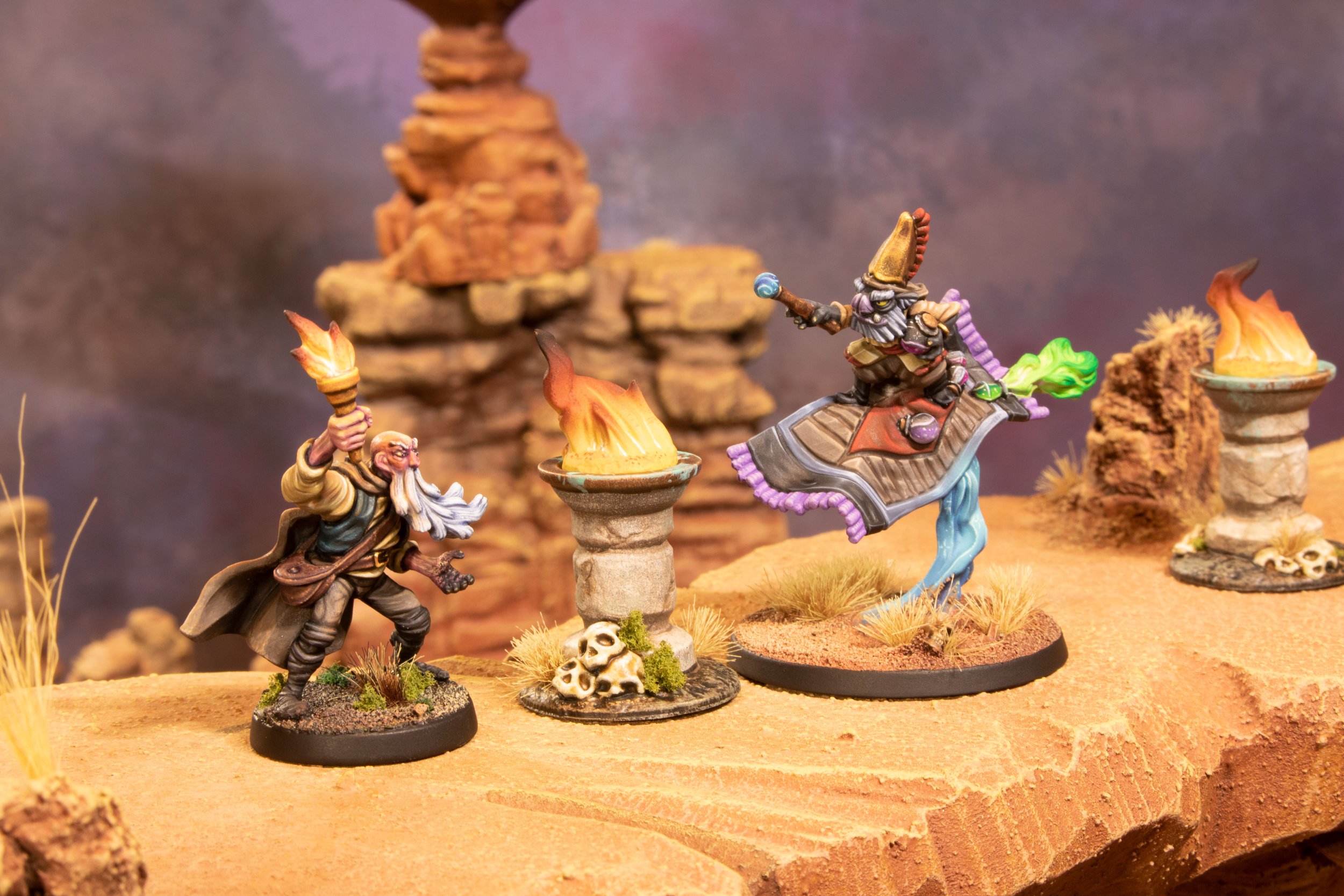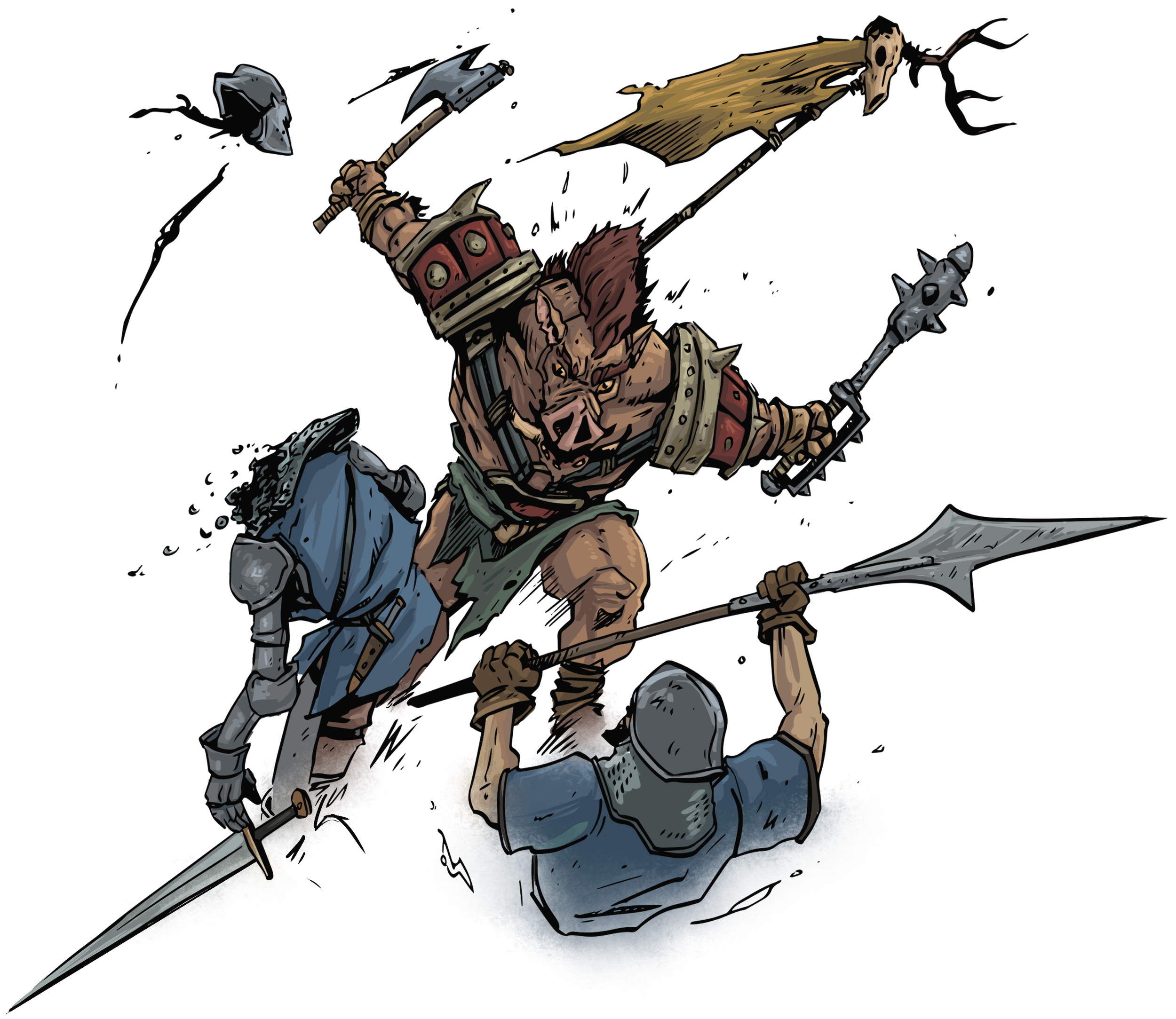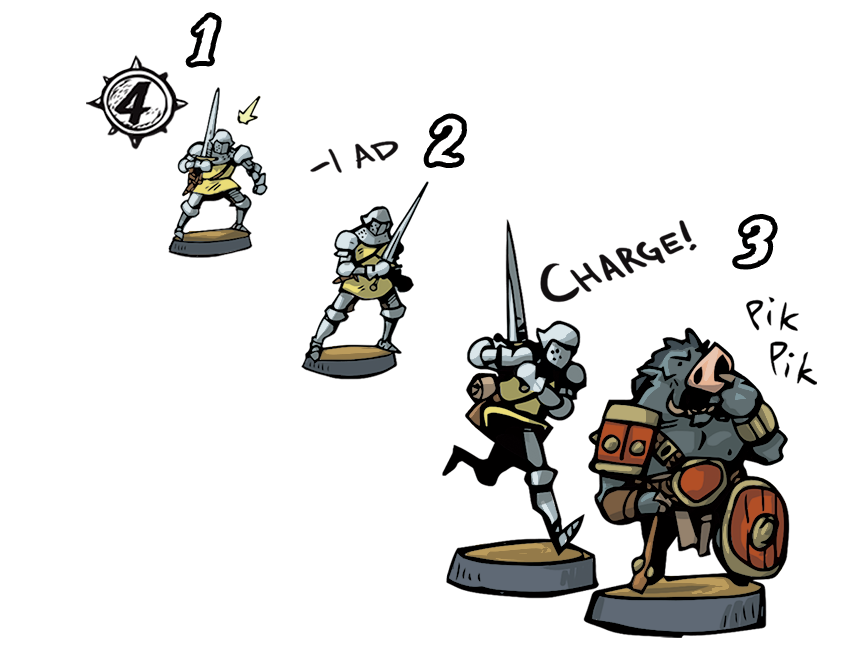
Overview
Hobby Game: Relicblade is a miniatures game. Players collect, build, and paint detailed model kits of the heroes and villains of their world.
2-4 Players: Relicblade is a head-to-head adventure game for between 2 and 4 players. (Solo/coop modes exist)
30 Minute Games: Games generally last around a half hour.
4-6 Minis Per Player: Each player commands a party of adventurers. Full size games are 100 points, and most heroic characters with an upgrade are around 25 points.
Dice and Ranges: Relicblade uses six-sided dice and measures ranges in inches.
The Battlefield: Games play on a 2’x2’ play area. Gameplay is greatly enhanced by terrain features built from model kits or from scratch.
Learn to Play Relicblade!
Characters
Characters are represented on the table by detailed miniatures and on character cards.
Character Cards
Character cards describe the character’s stats and abilities.
-
Characters spend action dice, or AD, to perform actions. When a character activates they generate a pool of action dice
-
For each AD spent on movement, a character moves their speed in inches.
-
Characters gain a defense bonus equal to their armor stat.
-
In addition to basic actions, characters have three unique actions on their character card.
-
Health boxes are the character’s HP. One health box is marked for each damage the character sustains.
-
The inventory bar shows what types of upgrades the character can equip, Keywords grant access to special upgrades, and the point cost represents the character’s value.
Upgrade Cards
Characters gain new skills and equipment through upgrade cards.
-
There are five upgrade types. Tactics, Potions, Items, Weapons, and Spells.
-
A detailed description of the upgrade, including keyword requirements or number of uses.
-
Upgrade cards add a new action for the equipped character.
Upgrade cards can be slipped under the character card so that the available action is visible.
-
Upgrades cost points in pickup games and gold in campaigns.
Character Activations
Relicblade is played over a series of rounds. Each game round is broken into three phases, the initiative phase, the activation phase, and the recovery phase.
The bulk of gameplay happens during the activation phase. During the activation phase, players take turns activating one character at a time until all characters have been activated.
Action Dice
When characters activate, they generate a pool of Action Dice or AD. They then spend these dice to perform actions.
Action Dice represent effort over time. Characters with more dice can get more done during a combat round than characters with fewer dice. When an action die is rolled it represents how well the character did at the action.
Performing Actions
To perform an action, the player chooses an available action, determines the difficulty, rolls the required number of action dice, and adds the result. If the sum of the rolled dice meets or exceeds the difficulty, the action is successful and the action’s effects are resolved.
Actions
Characters spend Action Dice to perform actions during their activation. The details of an action are described in action bars.
With the exception of Movement, actions can only be performed once per activation.
-
There are seven action types. Melee Weapon, Ranged Weapon, Ranged or Melee Weapon, Natural Weapon, Passive Ability, Magic Spell, and Special Ability. Action types have implications for various rules interactions.
-
This section includes the name of the action and the range. If the range is not listed, the action has a 0.5” range.
-
The difficulty shows the number of dice required to perform the action and the target number that must be met or exceeded to successfully perform the action. Actions that show multiple dice require that number of dice and the difficulty target number is the sum of both dice.
Action Dice represent both time and effort. The number of dice required represent time and the difficulty target number represents the quality of effort required.
-
Attack actions have a damage bonus while other actions describe some other effect.
Basic Actions
All characters in the world of Relicblade have access to basic actions.
These actions are extremely important, fundamental game mechanics.
-
Improvised attacks represent a wide range of stomps, kicks, jabs, headbutts, and other non-weapon attacks.
Because each action can only be performed one per activation, there are times when a character needs one more attack to achieve their goals.
-
Focus represents a character taking extra time and effort to accurately perform an action.
Focussing allows a character to add one additional die to an action attempt. This greatly increases the chances of success.
Because focus is an action, it can only be performed once per activation!
-
Dodge represents a character entering a defensive stance. This key mechanic grants the user a dodge token.
After the character is hit by an attack and damage is rolled, they may choose to spend their dodge token to roll an additional defense die. This essentially grants between 1 and 6 additional armor against a single attack.
Performing a focussed dodge grants two dodge tokens!
Move Actions
Characters traverse a dangerous world using move actions. Move actions may be performed multiple times per activation.
-
Characters may move up to their speed in inches for each AD they spend. Characters may make multiple move actions during their activation.
Terrain features up to 1” tall do not impede or slow movement.
-
Characters can climb up and down vertical surfaces. Climbing is +1 difficulty per inch climbed, rounding down.
To perform a climb, roll the AD spend on movement. If the difficulty is met or exceeded, place the character at the top of the climbed terrain. If the climb fails, they remain at the bottom of the climb.
-
Characters can jump up to 3” to cross gaps. Jumping is +2 difficulty per inch, rounding down.
If the jump succeeds, place the character on the other side of the gap, if the jump fails the character falls.
-
If a character falls they may suffer injury. The damage total for a fall is 2 per inch. The character defends against the damage total as normal.
Combat
As an adventure battle game, combat is a major part of Relicblade.
Engagment
-
Characters have a 0.5” engagement range.
Melee weapons and natural weapons with longer range may be used to engage enemies from further away.
-
If an unengaged character ends it move engaging an enemy, it benefits from a charge. Charging character gains one bonus AD to immediately perform an attack action.
-
When a character attempts to move out of, or through, the engagement range of an enemy, they must disengage. The moving character and all engaging enemies roll a die. If the moving character rolls equal or higher than any other die, they move freely. Otherwise they do not move.
Characters may focus to disengage.
Combat Actions
-
The player states what action is being used, who is being targeted, and measures range to the target.
-
The player rolls the required number of action dice to meet or exceed the difficulty.
-
If the attack was successful, the attacker rolls a damage die and adds the damage bonus.
The defender then rolls a defense die and adds their armor bonus.
The defense total is subtracted from the damage total.
Any remaining damage is dealt to the defender.
-
Starting from the left, health boxes are marked until all damage has been accounted for.
If the broken bone icon is marked, the character is critically wounded and will suffer -1 AD when they activate again.
If the skull icon is marked, the character is disabled!
Tactical Situations
-
When the final health box is damaged, the character is disabled. Disabled characters do not engage enemies and do not activate.
If a disabled character takes one more damage they are removed from play.
-
Disabled characters cannot be targeted by attacks while engaged by a friendly character.
Characters may not attack a disabled character while engaged by an enemy.
-
To use a ranged weapon attack, the character must be unengaged and able to draw line of sight to the target. Characters may shoot into combat without penalty.
To determine line of sight, look from eye level of the miniature toward its target. If any part of the target is visible, it is within line of sight.
-
If a character is defending against a ranged weapon attack while within 0.5” of intervening terrain, they gain +2 armor against the attack.
-
Spells and special abilities may be used while engaged by an enemy and targets do not gain cover against them.
-
At the end of each round, once all character have activated. Play enters the recovery phase.
During the recovery phase, roll a die for each disabled character in play. On a 6, the disabled character recovers one health and may activate as normal during the next round.
Activation and Combat Example
1. The Knight begins his activation with four AD.
2. The Knight spends one AD to move closer to the unsuspecting pig.
3. The Knight spends one AD to move closer still. The movement ends engaging the pig, resulting in a charge. The Knight may now use the bonus die from the charge to make an attack action.
4. The Knight chooses to use his charge die and another AD to perform Vicious Strike. Vicious Strike is difficulty 7 and requires the use of two AD.
5. The Knight decides to use his focus action to roll three AD, nearly guaranteeing success. The Knight rolls all three dice and hits with a 7. That was a close one.
6. The Knight rolls a damage challenge die and adds the damage bonus. He rolls a 4 and adds 5 for a damage total of 9.
7. The Shield Pig rolls a defense challenge die and adds his armor bonus of 2. He rolls a 2 and adds 2 for a defense total of 4.
8. The Shield Pig subtracts his defense total from the damage total and suffers the remaining five damage. When the final health box is marked, he is disabled, and ignores any excess damage.
9. The Knight has spent all of his action dice and his activation ends. The disabled pig remains in play until he is damaged again. During the recovery phase it is possible he will stand back up, ready to fight.






















